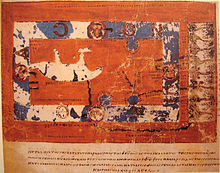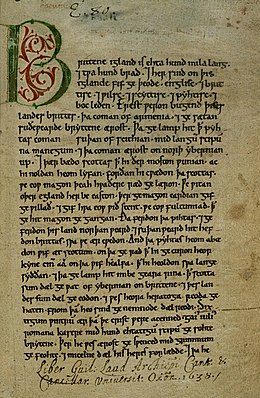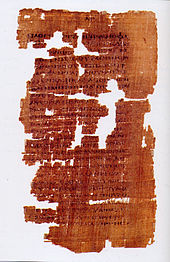He Took Chempaka Raman Pillai to Germany
A European Communist spy lived once in Travancore.
In a book he wrote, Travel Letters From Ceylon, Australia and South India ( B. Westermann Co., New York, 1931), he remembered Thycaud Ayya Swamikal, the spiritual Guru. He shared this story:
"One-day Ayya guru was very impatient and restless, walking round and round. The spy asked him what the matter was. The guru told him that he was expecting two of his disciples who had gone to meditate at Maruthwamala to bring a certain plant which he needed for some experiment. After some time two boys entered the scene. The guru eagerly asked, "Did you bring what I had asked you to bring ?"
"The senior of the two boys with some hesitation said "We have brought what you wanted" and took out something from his mundu and placed it on the table. It was a gold coin which probably they had purchased from the market. The guru's face became red with anger. Seeing this, the boys made a quick exit. The spy asked, "Sir, you should be happy since they have gifted you a gold coin. Why are you angry ?"
"Then the guru said, "They are making fun of me. They think I am greedy for gold. They do not understand my real purpose. What I need is a certain plant for an alchemical experiment which requires this plant. The plant is only for cleaning the brass coin. The real transmutation process is psychical". The spy grabbed the golden opportunity. He offered to bring the plant. The guru at first was reluctant, saying that being a foreigner he may not be able to converse with the local people and get the plant. But the spy was very enthusiastic and at last, the guru told him the name of the plant. The spy hired a horse-drawn carriage, went to Maruthwamala and brought a carriage full load of the plant. This pleased the guru and he included the spy in the experiment in place of the two boys who never showed up again."
If the two boys in this story are Chattampi and Narayana Guru, it may fail in chronology. So let us take it as just two boys. It is said that the British had sent a spy to keep a watch on Ayya's alchemy experiments. The spy was a man with anarcho-marxist views.
 |
| Walter Strickland, last portrait |
The spy was Walter William Strickland, who found Chempaka Raman Pillai and sent him to Germany.
There lived a Vellala couple Chinna Swami Pillai and Nagammal in Trivandrum in a house where the present Accountant General office is situated. Chempaka Raman alias Venkidi was born to them on 15 September 1891. Even during his Model school days he rallied against the British and shouted 'Jai Hind' on the school campus. Fearing retribution, the Principal called in the police. A Constable, Chinnaswami Pillai was sent to investigate the misdemeanour of the erring student. It turned out to be his own son.
In 1908, a British Biologist, Walter Stickland was camping at Trivandrum and he had claimed he had come to study butterflies that were found in the Western Ghats. He met a boy, T Padmanabhan Pillai, who had written a paper in a well-known science journal about the ability of spiders to change their colour, on one of his field trips. Strickland was impressed by the skills of the 18-year-old boy and took him to Europe for further studies. Along with him his close friend, cousin and neighbour, 17-year-old Chempaka Raman was also taken to Europe. He continued his education in Zurich and Germany. That he studied in Zurich, not Italy, and Strickland financed it, is confirmed by Harald Fischer-Tine, in the biography, Shyamji Krishnavarma: Sanskrit, Sociology, Anti-Imperialism.
This book also records: "Aldred's heroic act of solidarity directed the attention of another illustrious representative of British anarchism, Sir Walter Strickland, towards Krishnavarma's anti-imperial campaign. Strickland was a rather eccentric British aristocrat who had left his homeland in 1889 and stubbornly refused to return even after he had succeeded to the title of Baronet and the inherited family estates in Yorkshire in 1909. The 'anarchist Baronet", who was at least according to British intelligent sources, o of doubtful sanity' became something of a celebrity all over the English-speaking world. His anti-British activities were reported and humorously commented upon by the popular press of various countries. Strickland was a man of letters and had published translations of Latin and French classics as well as Czech poetry and fairy tales before he spent years in India and South East Asia. It was during his sojourn in the East that he came to the conclusion that 'The English and the despotism there...was nothing but a Camorra of infamous, bestial and obscene thieves, murderers, liars and worse' and turned into a staunch anti-imperialist. In the following years, he published a number of pamphlets and books containing trenchant attacks on British imperialism, one of which was extensively reviewed by Indian Sociologist*. When he read about Aldred's conviction, he sent him a telegram of congratulations and a cheque for 10 pounds...Together with Shyamji, the 'anarchist Baronet' was also one of the assessors of the pro-India committee founded in Zurich in 1912 his south Indian protege Champaka Raman Pillai."
Padmanabhan Pillai is referred to as Raman's brother in history-it doesn't matter.
It is said Raman and Padmanabhan studying in the same Model School, helped Walter Strickland to collect samples of plants and trees and the English man was impressed with the young Chembakaraman and asked him to accompany him to Austria where he had contacts and facilities. Chempakaraman agreed to accompany him and left with him for Austria. Walter Strickland put him in a school in Vienna to complete his school education and later he joined a technical school in Vienna where he got his diploma in engineering. When World War I broke out he along with many other Indians formed the “India ProIndia Committee” at Zurich and he was its president in 1914 and then moved to Berlin.In his 1992 book Europe and India’s Foreign Policy, Verinder Grover writes:
“When the first World War broke out, Indian revolutionaries abroad attempted to seize the opportunity to enlist German support for India’s fight for freedom… The emigre Indian revolutionaries in Europe, prominent among them a young south Indian called Chempakaraman Pillai, contacted the German embassy in Zurich. In September 1914, the International Pro-India Committee was formed, with Pillai as the president and Zurich as headquarters.”
From Zurich, Pillai ran the German/English monthly Pro-India, a magazine that put forward the Indian view of the world to the German people.
In October 1914, Pillai travelled to Berlin where a group of Indians had founded the Berlin Committee in support of the Indian cause. The following year, the International Pro-India Committee and the Berlin Committee combined to form the Indian Independence Committee.
Raman took a degree in Public Governance and Economics from Germany. He lived in Germany for 20 years. He carried campaign against British rule in India, With Virendranath Chatopadhyaya, Lala Hardayal, Raja Mahendra Pratap, Dr Prabhakar, A R Pillai and A.C. N Nambiar he founded Indian Independence CommitteeA R Pillai was Novelist C V Raman Pillai's son in law; Nambiar was writer Vengayil Kunjiraman Nayanar's son. Armed with an Engineering diploma, Raman joined German Navy. He was an officer on the cruiser” Emden” and attacked British ships and shelled several places in India. On September 22,1914 Madras was shelled.
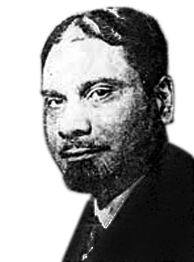 |
| Raman Pillai |
A free Government of India was established in Afghanistan on 1 December 1915 with Raja Mahendra Pratap as President Barkatulla as Prime Minister and Chempaka Raman Pillai as Foreign Minister. After World War 1 he formed an association with the “League of Oppressed People” In 1933 he met Subash Chandra Bose. They organized INA outside India. The Azad Hind Government was based on Pillai’s experience during World War I. In 1933 Pillai married Lakshmi Bai. Unfortunately, they had short life together. Pillai soon fell ill.
The mentor of Chempakaraman Pillai, Walter William Strickland (born Westminster 26 May 1851- died Java 9 August 1938 ) was the son of Sir Charles Strickland, 8th Baronet (1819–1909). He was the eldest son and the only child of his first marriage to Georgina, daughter of Sir William Milner, 4th Baronet, He was educated at Edinburgh Academy and Trinity College, Cambridge. He was the 9th Baronet, known as the Anarchist Baronet because he wandered around the world for much of his life espousing radical causes. The family estate was at Hildenley Hall in Yorkshire.
He married Eliza Vokes (1860–1946) in 1888. They had no children and the title passed to a cousin once removed, Sir Henry Strickland-Constable.
He wrote several books and pamphlets and translated works of the Czech poet Viteslav Halek, Moliere and Horace. He has been linked with the Voynich manuscript. He may have met Voynich during his first years in London, when Voynich was directly involved in the political activities of Russian refugees in London, under the leadership of Stepniak - Kravchinskii, who founded the SFRF (Society of Friends of Russian Freedom) and the RFPF (Russian Free Press Fund).
 |
Wilfrid Voynich
|
Wilfrid Voynich (born Michał Habdank -Wojnicz; 1865 New York-1930) was a Polish revolutionary, antiquarian and bibliophile. Voynich operated one of the largest rare book businesses in the world, but he is best remembered as the eponym of the Voynich manuscript.
He attended a gimnazjum in Suwałki (a town in northeastern Poland), and then studied at the universities of Warsaw, St. Petersburg, and Moscow. He graduated from Moscow University in chemistry and became a licensed pharmacist.
In 1885, in Warsaw, Wojnicz joined Ludwik Waryński's revolutionary organization, Proletariat. In 1886, after a failed attempt to free fellow conspirators, Piotr Bartowski (1846-1886) and Stanisław Kunicki (1861-1886), who had both been sentenced to death, from the Warsaw Citadel, he was arrested by the Russian police. In 1887, he was sent to penal servitude at Tunka near Irkutsk.
Whilst in Siberia, Voynich acquired a working knowledge of eighteen different languages, albeit not well.
In June 1890 he escaped from Siberia and travelling west by train got to Hamburg, eventually arriving in London in October 1890. Under the assumed name of Ivan Kel'chevskii at first, he worked with Stepniak, a fellow revolutionary, under the banner of the anti-tsarist Society of Friends of Russian Freedom in London. After Stepniak's death in a railway crossing accident in 1895, Voynich ceased revolutionary activity.
Voynich became an antiquarian bookseller around 1897, acting on the advice of Richard Garnett, a curator at the British Museum. Voynich opened a bookshop at Soho Square in London in 1898. He was remarkably lucky in finding rare books, including a Malermi Bible in Italy in 1902.
In 1902 he married a fellow former revolutionary, Ethel Lilian Boole, daughter of the British mathematician George Boole, who Voynich had been associated with since 1890. Voynich was naturalised as a British subject on 25 April 1904, taking the legal name Wilfrid Michael Voynich.
Voynich opened another bookshop in 1914 in New York. With the onset of the First World War, Voynich was increasingly based in New York. He became deeply involved in the antiquarian book trade and wrote a number of catalogues and other texts on the subject.
Voynich relocated his London bookshop to 175 Piccadilly in 1917. Also in 1917, based on rumours, Voynich was investigated by the FBI, in relation to his possession of Bacon's cypher. The report also noted that he dealt with manuscripts from the 13th, 12th, and 11th centuries and that the value of his books at the time was half a million dollars. However, the investigation did not reveal anything significant beyond the fact that he possessed a secret code nearly a thousand years old.
The most famous of Voynich's possessions was a mysterious manuscript he said he acquired in 1912 at the Villa Mondragone in Italy, but first presented in public in 1915. The book has been carbon-dated, which revealed that the materials were manufactured sometime between 1404 and 1438, although the book may have been written much later. He owned the manuscript until his death.
 |
A page from Voynich's manuscript
|
The Voynich manuscript is an illustrated codex hand-written in an unknown writing system. The vellum on which it is written has been carbon-dated to the early 15th century (1404–1438), and it may have been composed in Italy during the Italian Renaissance. The manuscript is named after Wilfrid Voynich, a Polish-Samogitian book dealer who purchased it in 1912. Some of the pages are missing, with around 240 remaining. The text is written from left to right, and most of the pages have illustrations or diagrams. Some pages are foldable sheets.
The Voynich manuscript has been studied by many professional and amateur cryptographers, including American and British codebreakers from both World War I and World War II. The manuscript has never been demonstrably deciphered, and the mystery of its meaning and origin has excited the popular imagination, making it the subject of novels and speculation. None of the many hypotheses proposed over the last hundred years has been independently verified. In 1969, the Voynich manuscript was donated by Hans P. Kraus to Yale University's Beinecke Rare Book and Manuscript Library.
In his correspondence preserved in the Beinecke Library, Voynich reveals that he has been introduced to the Jesuits of Villa Mondragone by one "Father Strickland", who lived here. It credits the origin of the manuscript and the purchase to Villa Mondragone.Villa Mondragone was built in 1573-1577 by Cardinal Marco Sittico Altemps.Cardinal Altemps enlarged the existing villa Tusculana, a work done in 1571. One of his guests was Cardinal Ugo Boncompagni, who became pope Gregorius XIII a few months later. He suggested building a new villa on the hill overlooking the villa Tusculana, on the Roman ruins of the Qunitili's villa. The Villa is called Mondragone referring to the coat of arms of the family Boncompagni (a dragon). The Villa received the Pope and his court for a long time.
In 1613, Cardinal Scipione Borghese, nephew of pope Paul V, bought villa Mondragone and villa Tusculana, together with other properties of duke Gian Angelo Altemps, nephew of cardinal Marco. In 1621, at the death of Paul V, the decline of villa Mondragone began.
In 1865, the owner of Villa Mondragone, Don Marcantonio Borghese, signed an agreement with the Jesuits in order to use the Villa as a college for the Italian nobility. The "Nobile Collegio Mondragone" opens its doors on February 2, 1865. The Jesuits bought Villa Mondragone in 1896.
Since three fathers with the name Strickland were associated with the Villa, the relationship between the anarchist Strickland to Voynich needs further research. Rev W Strickland, a Jesuit was Military Chaplain in India for 12 years and wrote the book, Catholic Missions in Southern India to 1865.
Strickland spent some time in Russia and in 1923 became a citizen of Czechoslovakia, renouncing his British citizenship and the Baronetcy. Encyclopedia of Literary Translation Into English states:
"The virtually unknown English eccentric was a traveller and free thinker with a taste for anarchism and Buddhism, but he managed to find time to learn Czech and to translate poems. The quality of the translation is rather good but again the impact on the British public was nil and they are long out of print".
He had libertarian, socialist and atheist ideas. He helped Guy Aldred, founder of the Glasgow Anarchist Group.
As related by Albert Meltzer: " After the publication of Hyde Park in 1938 support for Aldred in London fell off and he had burned his bridges in London and Glasgow, but then an extraordinary chance ended his days of poverty. Sir Walter Strickland, a millionaire whose family practically owned Malta, had during the First World War taken to him and was disgusted with the British Government after the Versailles Treaty. In acknowledgement of the newly created State of Czechoslovakia, the first fruit of League of Nations liberal idealism, Strickland became a naturalised Czech (1923), though he never went to that country. In 1938 Strickland died and left a fortune to Aldred, who promptly formed the Strickland Press, bought a hall, bookshop and machinery and proceeded to reprint all his old pamphlets, before actually getting the money. Then the Strickland relatives brought a suit saying the will was invalid. Strickland had said in his will he left the money to Aldred "for socialist and atheist propaganda", illegal under Czech law. There was a complicated legal case which ended as such things usually do, with the money in the hands of the lawyers. Aldred, used to defending his own cases personally and handling courts with ease on matters of obstruction and sedition, found himself outgunned among the moneyed lawyers ".
Albert Mezler was an English anarcho-communist and contributor to the anarchist paper Freedom, who wrote, Anarchism, For and Against.
According to John Taylor Caldwell: "Walter was an eccentric. He preferred books to the pursuits of normal young men of his class and had no interest in sport, drink, gambling or women. His father was disappointed and disgusted. One day when he was having it out with Walter (probably not for the first time) about his unsatisfactory lifestyle, and the fact that he was nearing forty and still not married, Walter rose from the table and, so the story goes, proposed to the first girl he met, who happened to be the kitchen maid."
Caldwell was a Glasgow-born anarchist communist and biographer of anarchist, Guy Aldred.
In the early 1890s, Strickland went to live abroad.
After 1912 Strickland did not live in England. Eventually, he settled in Java and became a strong opponent of imperialism.
He gave Sun Yat Sen £10,000 "to help him start a revolt against the Emperor of China".During the First World War, Strickland donated £10,000 to his friend Tomáš Masaryk's Czechoslovakian Independence Movement. He left Guy Aldred £3,000 and with this money he bought some second-hand printing machinery and established The Strickland Press. Over the next 25 years Aldred published regular issues of the United Socialist Movement organ, The Word and various pamphlets on anarchism. Thomas Masaryk ( 1850 – 1937), was a Czechoslovak politician, statesman, sociologist and philosopher. Until 1914, he advocated restructuring the Austro-Hungarian Empire into a federal state. With the help of the Allied Powers, Masaryk gained independence from the Czechoslovak Republic as World War I ended in 1918. He co-founded Czechoslovakia together with Milan Rastislav Štefánik and Edvard Beneš and served as its first President, and so is called by some Czechs the "President Liberator".
In 1909 Guy Aldred was sentenced to twelve months of hard labour for printing the August issue of The Indian Sociologist, an Indian nationalist newspaper edited by Shyamji Krishnavarma. Strickland heard of Aldred's action and sent him a telegram of congratulation to the prison and a cheque for £10.
 |
Guy Aldred
|
Guy Alfred Aldred (often Guy A. Aldred; 1886 – 1963) was a British anarchist communist and a prominent member of the Anti-Parliamentary Communist Federation (APCF). He founded the Bakunin Press publishing house and edited five Glasgow-based anarchist periodicals: The Herald of Revolt, The Spur, The Commune, The Council, and The Word, where he worked closely with Ethel MacDonald and his later partner Jenny Patrick.
The Indian Sociologist was an Indian nationalist newspaper edited by Shyamji Krishnavarma. When Krishnavarma left London for Paris, fearing repression by the authorities, the printing of the newspaper was first taken over by Arthur Fletcher Horsley. However, he was arrested and tried for printing the May, June and July issues. (He was tried and sentenced on the same day as Madan Lal Dhingra, who was convicted of the assassination of Sir William Hutt Curzon Wyllie). At Horseley's prominent trial the Lord Chief Justice, Lord Alverstone, indicated that anyone printing that sort of material would be liable for prosecution. Nevertheless, Aldred, as an advocate of the free press, published it, bearing his own name. The police obtained a warrant and seized 396 copies of the issue. At the trial, the prosecution was led by the Attorney General, Sir William Robson, at the Central Criminal Court. Robson highlighted parts of TIS that Aldred had himself written, particularly focussing on a passage which touched on the execution of Dhingra:
In the execution of Dhingra that cloak will be publicly worn, that secret language spoken, that solemn veil employed to conceal the sword of Imperialism by which we are sacrificed to the insatiable idol of modern despotism, whose ministers are Cromer, Curzon and Morley & Co. Murder - which they would represent to us as a horrible crime when the murdered is a government flunkey - we see practised by them without repugnance or remorse when the murdered is a working man, a Nationalist patriot, Egyptian fellaheen or half-starved victim of despotic society's bloodlust. It was so at Featherstone and Denshawai; it has often been so at Newgate: and it was so with Robert Emmett, the Paris communards, and the Chicago martyrs. Who is more reprehensible than the murderers of these martyrs? The police spies who threw the bomb at Chicago; the ad-hoc tribunal which murdered innocent Egyptians at Denshawai; the Asquith who assumed full responsibility for the murder of the workers at Featherstone; the assassins of Robert Emmett? Yet these murderers have not been executed! Why then should Dhingra be executed? Because he is not a time-serving executioner, but a Nationalist patriot, who, though his ideals are not their ideals, is worthy of the admiration of those workers at home, who have as little to gain from the lick-spittle crew of Imperialistic blood-sucking, capitalist parasites at as what the Nationalists have in India.
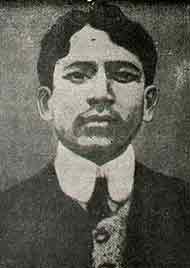 |
Madanlal Dhingra
|
Aldred also remarked that the Sepoy Mutiny, or Indian Mutiny, would be described as The Indian War of Independence. Aldred received a sentence of twelve months of hard labour. His involvement with The Indian Sociologist brought him into contact with Har Dayal, who combined anarchism with his Indian Nationalism, based on his view of ancient Aryan culture and Buddhism.
Disaffected with Britain, in 1911, Strickland sold the family home, which became a convent. After 1912, he did not live in England. On August 15 1913 The Argus of Melbourne reported:
ANARCHIST BARONET
Sir Walter Strickland
Scholar and Gipsy
LONDON, Aug. 14.
Sir Walter Strickland, the "anarchist
baronet," who has been missing from his
accustomed haunts on the Continent for
sometimes, and for whom his friends have
been searching, is reported to be living
quietly at Geneva. He took a prominent
part in the recent formation of a committee
to promote freer trade for India.
Sir Walter, who is the ninth of his line,
and whose title dates from 1641, was born
62 years ago, and succeeded his father four
years ago A scholar and savant of undo
repute, he is called a gipsy and an anarchist,
owing to his wandering habits and politi
cal theories He is a linguist of ability,
verged in both ancient and modem lan
gauges, and won wide fame by his transía
lions of Moliere and Horace.
It is said that during his 62 years he
has spent only 1 week in London
Sir Walter once declared that he had
hidden on the Continent because he had received a warning "from an
absolutely reliable source" that powerful
officials were plotting his assassination. In
Vienna the baronet was arrested because
he was thought to be Ugo Schenek, a
murderer .' This was a great compliment,"
commented the baronet, ' for Schenek was
described as extremely handsome and
aristocratic looking ". Upon succeeding to the
title, Sir Walter announced his intention of
removing every scrap of his property to the
Continent, and for the future to have as
little as possible to do with England and
its people.
In a letter to a London newspaper Sir
Walter wrote -"The vulgar, ungentle
manly, and, indeed, murderous
persecution to which I have been subjected is ex
exclusively British " The 'anarchist baronet"
comes of an ancient family that had its seat
at Strickland, in Westmoreland, before the
Conquest, and one of Sir Walter's ancestors,
carried the banner of St George at Agincourt.
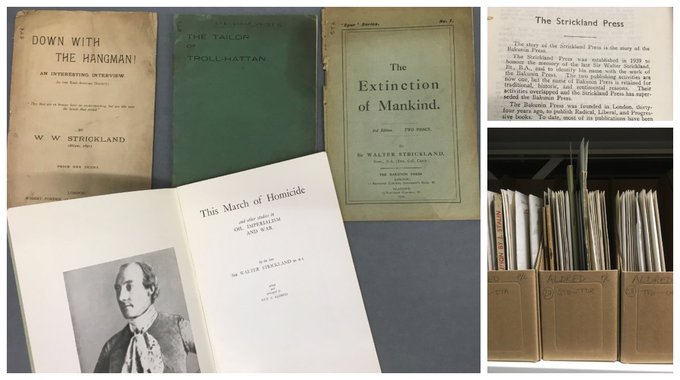 |
| Archive box no 27 of Aldred Collection: Socialist pamphlets by Strickland; the photo seen is Strickland, just out of Cambridge |
After receiving Czechoslovakian citizenship in 1923, he renounced his British citizenship and in 1931, moved to Java, where he died on 9 August 1938. His two works of some interest are Sacrifice; Or, the Daughter of the Sun (1920), a tale with Lost Race implications, and the more ambitious Vishnu; Or, the Planet of the Sevenfold Unity (1928), in which a distant planet, whose inhabitants are divided into seven Sexes, is visited.
William A Stricklin in the book, Family Secrets, writes that Strickland willed his vast wealth to print communist pamphlets. The information comes under the subheading, Family Idiots. Though Strickland had become a neutralized Czech, he never went to that country. When he died, he left his entire fortune to Aldred who promptly formed the Strickland Press, bought a hall, bookshop, and machinery and proceeded to reprint all his old pamphlets, before actually getting the money.
There is a slightly different version: Strickland left most of his money to peace causes of which Guy was the executor. Due to Strickland's hatred of Imperial Britain most of his money was invested in countries that would be at war with Britain before the will was probated. Guy received £3,000, and with this, he bought some second-hand printing machinery and Bakunin Press - renamed Strickland Press in memory of Sir Walter - moved into 104-106 George Street Glasgow. Strickland Press set about republishing many of Guy's pamphlets and the Word, which would appear every month for 25 years, for 22 years of this period a free copy of the Word was sent to every Labour MP.
The Strickland relatives brought a lawsuit saying the will was invalid. Strickland had said in his will that he had left the money to Aldred "for Socialist and atheist propaganda", illegal under Czech law. There was a complicated legal case which ended as things usually do, with the money in hands of the lawyers. Aldred used to defend his cases personally and handle courts with ease on matters of obstruction and sedition, found himself outgunned among the moneyed lawyers. Strickland disregarded Lincoln's admonition not to represent himself. Aldred was left out of pocket only to be saved, financially, by the Marquis of Tavistock. Through Tavistock's support, Aldred was able to begin work on his monthly The Word - a periodical of the United Socialist Movement which was one of the key publications produced by the Strickland Press.
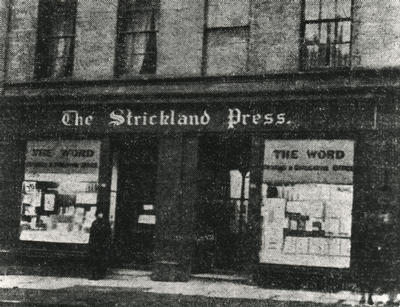 |
|
The Marquis of Tavistock - who became the Duke of Bedford - committed suicide after the Second World War, making no provision for Aldred in his will. Nevertheless, Aldred continued to publish The Word until his death in 1963 supported by Ethel MacDonald and Jenny Patrick. MacDonald acted as manager and bookkeeper of the company until her death in 1960, setting type and printing alongside Patrick who continued working at Strickland Press until its dissolution. The George Street premises had to be vacated in 1962 when they were demolished to make way for the expansion of the Royal College of Science and Technology, which later became the University of Strathclyde which now hold Aldred's archive. The Strickland Press was continued by John Taylor Caldwell until its closure in 1968.
Chempaka Raman, after the first world war, continued to work in a German company but kept his efforts for Indian independence alive. In 1930 he became the representative in Berlin of the Indian Chamber of Commerce. He was the only white in the National People's Party that supported the Nazis. In a press meeting on 10 August 1931 Hitler said that if non-Aaryan Indians were ruled by the British, it is their fate. This irritated Raman. On 4 December, Hitler said: "Britain losing India would not augur well for any nation, including Germany".
Raman wrote to Hitler: "You seem to attribute more importance to the colour of the skin than to the blood. Our skins may be dark; not our hearts".
Hitler sent his Secretary to Raman to apologize but expressed his irritation at being attributed with a black heart. Their friendship came to an end. In January 1933, Hitler became the Chancellor. Nazis raided and arrogated Raman's house in Berlin; he was manhandled and bundled out. He moved to Italy for treatment. Blood had clotted in his brain. He had no money for treatment. He died on 28 May 1934, in an ordinary nursing home. Hitler killed him.
My enquiries at the University of Strathclyde Archives and Special Collections and the Glasgow Mitchell Library reveal that in the Aldred collection there, "bundle 49 dated 08/08/1939, contains a letter from the wife of Chempaka Raman Pillai, adopted by Sir William Strickland, about her husband’s disappearance enclosing an article about Strickland."
His wife, Lakshmi Bai from Satara in Maharashtra returned to Mumbai with his ashes in 1935. She had valuable documents on Raman. She lived alone in a flat in Church Gate allotted to her by Morarji Desai. She died in December 1972 in St George Hospital, due to starvation. The unidentified body was identified by Journalist P K Ravindranath. Her famished fingers still clenched 17 keys that protected her husband's documents. The documents were transferred to the National Archives.
Padmanabha Pillai returned to Trivandrum and became a Curator with the help of the royal family. During this period, he went to the University of Bern to present a paper on frogs. On his way back, he disappeared without a trace, but his coat was retrieved from a beach in Thailand; his belongings reached Colombo. His father-in-law burned all his remaining documents. Butterflies, spiders and frogs do exist.____________________________
*Pagans and Christians
Note: I am indebted to Carol Stewart, Senior Library Assistant, and Dr Anne Cameron, Senior Archives Assistant, University of Strathclyde Andersonian Library, Glasgow, UK for providing me with the last portrait of Strickland, by digging deep into the archives.
© Ramachandran



















